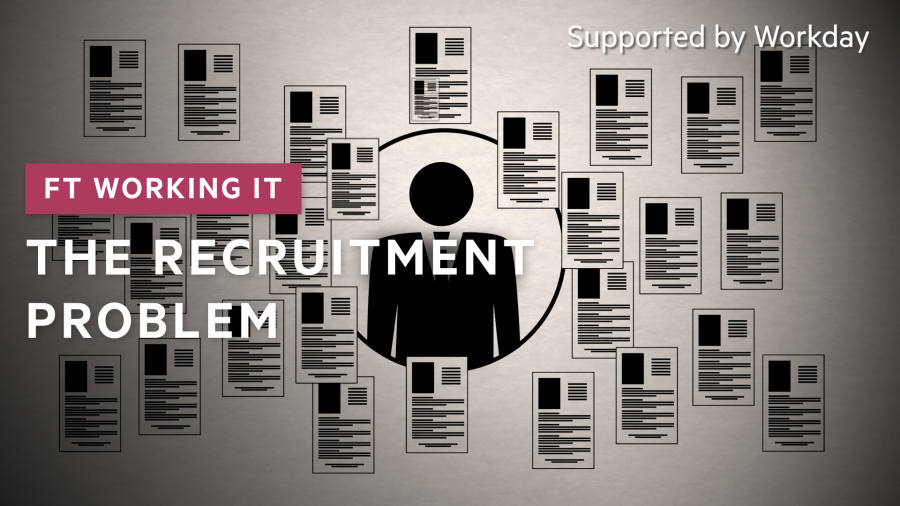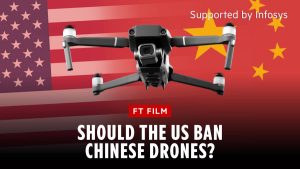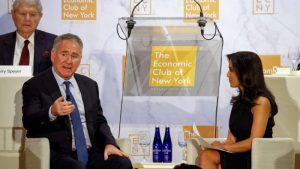Recruitment is broken, what are businesses doing to fix it?

You can enable subtitles (captions) in the video player
Businesses are fighting a skills shortage.
Over the next 20 years, our working age population is going to shrink by on average 25 per cent.
Those lakes for talent will just keep getting smaller and smaller.
They’re facing two massive shifts, a rapidly ageing population with fewer young people entering the workforce and the rise of generative AI. I’m going to look at the lengths employers are going to in order to secure the best candidates. If recruitment is broken, what are businesses doing to fix it?
I’m Isabel Berwick. I host the FT’s Working It podcast, and I write a newsletter about the workplace. In this series, I’ll explore some of the most pressing issues around the future of work and talk to senior leaders about how they’re making work better.
How do you navigate the tensions that you come across as a leader?
Recruiters are struggling. The numbers of applicants for almost every job have gone up sharply. And finding the best person for the role from thousands of applicants is a huge time commitment for hiring managers. AI-driven recruitment is creating an arms race on both sides. Are we in danger of losing the human from human capital?
This is the conundrum, isn’t it? That you have 100, 1,000 applications for each job, and yet they can’t recruit. And there are gaps, partly driven by technology in general, makes it very easy to apply. So I think you have more applicants, but the talent that you want is still as thinly spread as ever.
Take the legal industry at the moment. We’ve seen the arrival of American law firms. And they are battling over those people. So they’re battling with money. People who’ve come out of their training contract being offered salaries. We’ve heard of £150,000, £180,000 a year, whereas the UK firms were probably still pretty good at 60,000 to 80,000 originally.
The much publicised high salaries for young lawyers are an outlier. But law isn’t the only sector where businesses have to fight for the top candidates. There are talent shortages across many industries, especially as many older, skilled and highly qualified staff leave the workforce. Unretirement is one of the biggest trends in recruitment right now.
So I went to meet Lyndsey Simpson, founder and CEO of the 55/Redefined Group, which works with big companies, helping them to attract and keep talented people in their 50s and beyond.
There are three key problems associated with recruitment and an ageing population. The very first one is that people aren’t having enough sex. Or if they are having sex, they’re not having babies as the end result of that. And so we now find ourselves, in most western economies, with the lowest birth rates on record, which means that over the next 20 years, our working age population is going to shrink by on average 25 per cent.
So 16 to 60-year-olds shrink. Whereas the over 60s population grows at over 40 per cent in that same time zone. So if we continue to recruit youth and early talent, then A, that pool is getting one per cent, two per cent shrinker every year.
What role are over 50s going to be playing in workforces?
It’s a real big shift in the next five years. So between now and 2030, 50 per cent of the workforce will be aged 50 or over.
50 per cent?
50 per cent by 2030 in the UK, and over that in parts of Asia and other territories, and just shy of that in the US. That’s staggering.
So are people work you with more concerned with leveraging the skills of their existing workforce, perhaps making the most of people who are over 50? Or are they interested in plugging those talent gaps by recruiting older people?
I would say 95 per cent were solving a very clear business problem. So if your infrastructure, or your utilities, or you have mainframe engineers, all sorts of sectors are reliant on skills, actuaries, where there is nobody under the age of 50 for at least a good 20 years coming through. And so the challenge is now to extend people’s careers by 10, 20 years and find new and intriguing ways to work with people so that they can prolong their career.
Lyndsey Simpson and other recruitment specialists have tapped into a powerful pool of talent that’s been overlooked. And she highlighted the issues that industries like accountancy are facing, with growing and retaining the talent necessary to do the job. Many employers have yet to utilise the over 50s recruitment market. Why? They can see the market is awash in people applying for jobs.
Employers and recruiters I’ve spoke to are frankly overwhelmed by the sheer number of CVs coming through. There’s this sea of sameness where recruiters are seeing the same phrases coming up in job applications and in CVs. Job seekers are using AI at all stages of the process. From the moment that they find a job that they want to apply for, sometimes shown to them by AI on a platform like LinkedIn or Indeed.
Then they get that job description and they can paste it into a chatbot like ChatGPT. They can ask it to write an application for them, write a cover letter, improve their CV, and then they just copy and paste it back in. Employers and recruiters, they’re saying they’re not actually seeing many good candidates using AI.
Some of them are saying because of AI, we’re not going to do cover letters and CVs anymore. We’re going to do something else. Because we just can’t trust them. Others are saying, if you use AI, we will immediately throw it out. And over at the other end of the spectrum are, if you like, we’ve talked to games companies who say, yeah, use AI, because we use it at work.
A wide selection of applicants to look at is great for an employer. What isn’t so great is that AI tools have lowered the barriers to application. It’s now much less effort than it used to be. A recent poll found 45 per cent of applicants had used generative AI to build or improve their CVs. Finding the right talented people can sometimes seem like a hopeless task for overwhelmed hiring managers.
International electronics company Siemens has found an innovative alternative route to identify the candidates best matched to their vacancies.
I think my business is a really nice microcosm of everything that is challenging out there around skills for the future. We still need great people to come in and safely use spanners and screwdrivers to fix grey boxes. But then we’re also moving into an era where those grey boxes will connect and we will create digital solutions from the data that those grey boxes provide, plus a layer on top of that around keeping that safe through cybersecurity.
So we’ve got an incredible period of workforce transformation. We almost have this absolute perfect storm, hence why those lakes for talent will just keep getting smaller and smaller. Often, the quality of the candidates were less than we’d been used to in the past. We were also going through a process where we’d get people right through to the end of the hiring process. And they would receive a better offer from someone else. So it was just becoming more and more difficult.
In our industry, where people’s experiences is highly valued and not certainly not rejected, that CV holds a lot of kudos. We decided, look, we need to do something a little bit different.
By teaming up with a recruitment company called Arctic Shores, which uses AI-powered and task-based psychometric assessments, Siemens is now recruiting for some roles on aptitude rather than qualifications and specific experience.
What’s been fantastic is that we’ve expanded our pool of talent. And that’s a pool of talent outside of the typical industry. We’ve got a very clear set of behaviours that work in our organisation. And I can now find people that’s behaviours match that to complement what we’re trying to do.
But I’m also encouraged by, when someone’s been with us two years, they’ve passed through and they’re moving on to a different role either within Siemens and sometimes outside. I think that’s how the workforce is moving towards, that job for life, however kind of romantic that sounds, I’m not sure it’s there. And with future generations, the same.
But if you get the behaviours right, then there is a far more likelihood that they will progress within the organisation because they’re fit and their value that they’re adding and we’re giving them, it’s symbiotic through the journey.
We just don’t have enough people with the skills. So it’s how do you assess somebody for those transferable skills and capabilities? That means that they could be really, really good for some of these roles that we’re struggling to fill. And we just need to look at the talent pool in a different way.
Combining neuroscience and psychology principles, Arctic Shores has created a number of tasks that score candidates based on how they think and learn. The company believes that AI used in this way can predict how an individual will succeed in a particular job. I invited its co-founder and CEO, Robert Newry, to the FT’s offices to see it for myself. Candidates have to complete a number of interactive, non-job related tasks, and are scored on how they approach them.
So your task here is to trial a new security system. And the idea around that is we want to see how you approach it, and as things get harder, how you adapt your behaviour. Good. You’re on the second one. This was the one where, oh, you just got it.
Oh, I did?
You did. You’re now to the third one, so it’s getting hard.
OK. Oh.
So what did I pick up from the way that you approach this? You’re somebody that grasps something quickly. And once you’ve grasped it, you want to get stuck straight into it.
So you’ll be able to spot the people who are incredibly impatient.
Some tasks, you want people to be really, really focused and to take time to do it. Other things, they have to think really fast on their feet, traders, sales roles. So you actually want them to be slightly impatient. So that’s the beauty of this.
So, Robert, what’s the difference between me doing this and how that applies to a recruiter or a particular job and me sending in my CV?
This is at the crux of the challenge that we’ve got at the moment in the recruitment process. Because in a CV, as we have here, you’re just going to be looking through a bunch of words, very subjective, full of bias and flaws.
Talk me through what they’re telling us and what they’re not telling us. This looks like a LinkedIn profile.
Exactly. Yeah. But ultimately, you either got the experience in here or you haven’t. And that’s what a recruiter is looking for. And quite often, people are just putting key words in there because they know that…
SEO, data analytics, you can just throw…
You can just throw those words out. Nobody’s got a way of validating against. So then what happens. This was a story that went on Reddit and LinkedIn. Angelina Lee, she got no interviews based on her standard CV. So she amended it just to put big brand names in there. But what else do you notice Isabel from her CV in there?
Spread herpes STD to 60 per cent of intern team. Connected with Reid Hoffman on LinkedIn and slid in the DMs.
Slid in the DMs. You’d have thought that that would just be a red flag in there.
And she’s quite impressive, fraternity record for most vodka shots in one night.
So how many interviews do you think she would have got by putting that in there compared to her normal CV?
I’m hoping none.
She got a 10 times increase. She got a 90 per cent acceptance rate for interview despite having that in there compared to a genuine CV because she hadn’t any of the big company experience.
Wow.
So employers, recruiters, and online job sites, they all use AI and have been using AI for some time. The way that employers and recruiters are using AI is to sift through applications. So that might be setting a specific thing that they want to filter out. So if you’ve been to university, they’ll include you. If you haven’t, they won’t. And they can detect that on a CV in the text.
This has been shown to be quite effective, but perhaps it’s not the best way of telling who the best candidate is. AI is trained on the data that we have in the world. And a lot of the data that we have is biased. It perpetuates inequalities in society that we already have. And that’s something that can catch employers off guard as well, because they are setting certain metrics based on the job. But they might not anticipate how the algorithm will work. And the algorithm might prefer certain types of candidates over another.
We ask employers every year, so what are you doing to assess applicants? And even today, CV cover letter comes out at like 90 per cent plus. Employers are generally risk-averse because it’s a big bet when you recruit somebody. A, you’ve spent a lot of time in the process of recruiting. Then you’re going to put a lot of, well, maybe cash, maybe just time into training. And you have plans that they’re going to be here, well, four or five, maybe more years. So it’s a big investment.
I’m not sure businesses are trying harder to get the best talent. I think they are trying equally hard, but limiting themselves to, let’s be honest here, that these are the people we know. We should look at everyone and then assess people on, well, can you do the job? Have you got the attitude that we want? I think they’re being pushed into it by the younger generation and diversity and EDI quite right.
But they’re also realising this is a good thing to do, because actually, if you have diverse or a wide range of voices in the room, you actually get better results.
I expect in another three to five years we will see a lot of companies utilise artificial intelligence to make sure that they can attract and retain the best talent.
I went to visit Swiss pharmaceutical company Novartis on its giant campus in Basel to see how it is approaching the recruitment crisis. Like many businesses, Novartis incorporates AI in its hiring processes. What makes it stand out is that corporate leaders have invested in AI that will boost the number of internal moves by its existing workforce.
I think the biggest challenges that we face is a real shortage of talent with specific skill sets. And so we really thought a lot about it. And we really came to the conclusion we need to do even more for the people who we have so that we can really develop and retain them.
Novartis has created a platform called Talent Match that pairs its staff to other opportunities around the organisation based on their skills and interests.
So I know a lot of companies are starting to think a lot more structurally about internal ability. You’re a bit ahead of the game. What are the benefits of it? And can you quantify how much money you’re saving on external recruitment?
One key benefit for us is enhanced engagement of our employees. We know that when people have access to opportunities, they’re more engaged. And we staff more than 500 projects through our employees. And it helped us to realise more than 50 million productivity. That’s a lot of money that you can then reinvest back into research and development. As we see that things are changing really quickly in how we operate, we can also post opportunities in new parts of the organisation and reallocate people way more quickly.
What I liked about this approach at Novartis is that it gives staff the chance to review their skills. Based on what an individual says about their ambitions, the AI will tell them what training and skills they still need to acquire before they are a match for their dream job. What’s key is that this kind of approach is scalable, replicable, and will only get easier as AI gets better at its job.
So the barrier to entry of applying for jobs has got even lower. The trick is going to be finding something that welcomes the widest group of applicants that you want, but is enough to say, do you really meet these criteria? Do you really think you can do this? The criteria being about these attitudes that you’re going to demonstrate when you get here.
The recruitment industry is going through a process at the moment where they’re learning how to use AI from the employer side as well to their advantage and perhaps save time, perhaps make things easier. And another thing I think it’s been doing in the recruitment sector is really making employers and recruiters pause and think, is a CV or an application necessarily the best way to determine who is good for the job? Are there other metrics we could be using?
The tech we use at work is changing so quickly that bosses and staff can’t keep up. But some employers can and are doing better at using AI to find new hires with the right skills, or to deploy training that will upskill existing staff. We need more of that in future if recruiters are to find and hire the right talent.
But humans don’t change. And we also need to keep the human touch if we are to fix the crisis in our recruitment pipelines. AI can’t do it all.
#Recruitment #broken #businesses #fix







